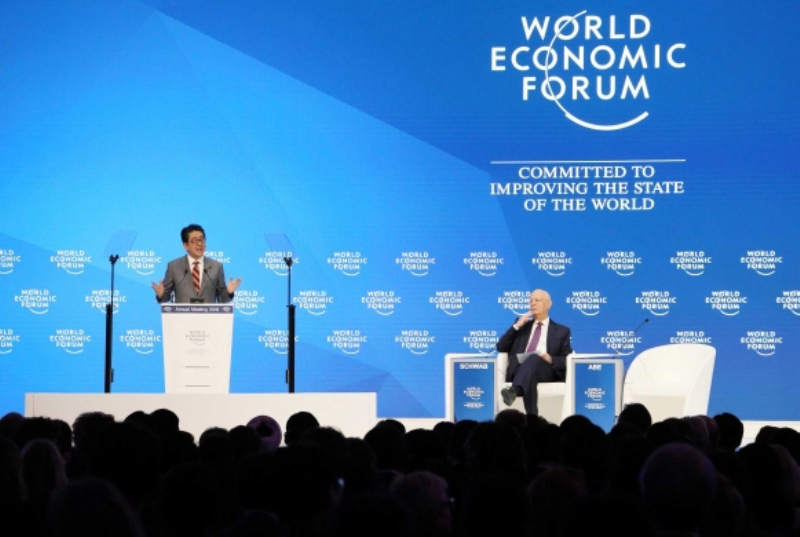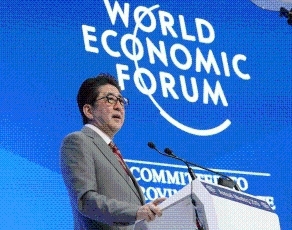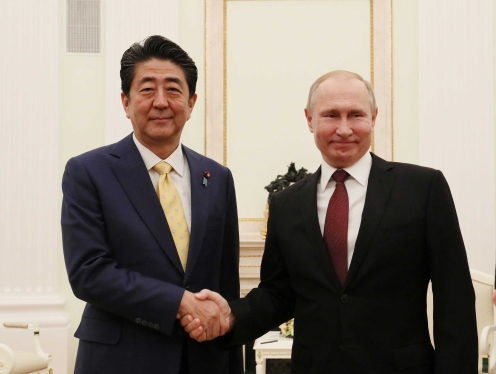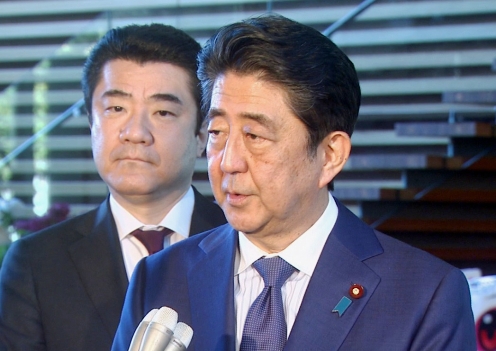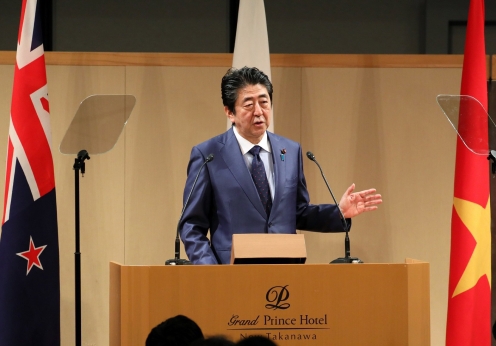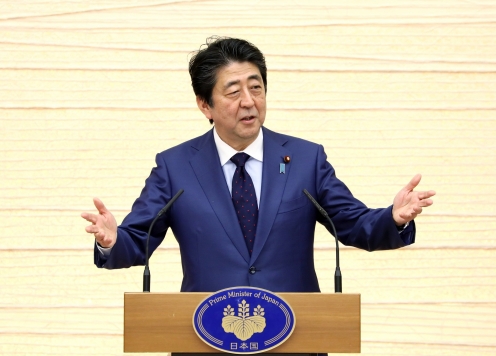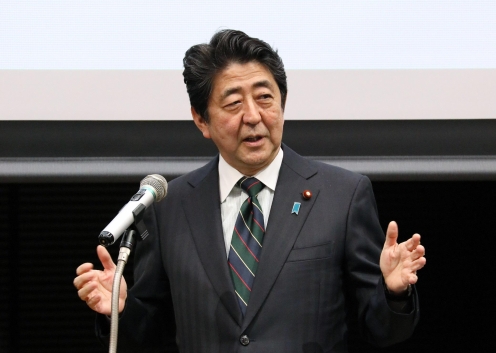The World Economic Forum Annual Meeting and Other Events
Cabinet Secretariat, Wednesday, January 23, 2019
[Provisional Translation]
On January 23, 2019 (local time), Prime Minister Shinzo Abe attended the Annual Meeting of the World Economic Forum held in Davos in the Swiss Confederation.
The Prime Minister attended the Annual Meeting of the World Economic Forum (Davos Meeting) and gave a speech. In the afternoon, Prime Minister Abe held talks with H.E. Mr. Jair Messias Bolsonaro, President of the Federative Republic of Brazil. Afterwards, the Prime Minister attended Japan Night.
Speech by Prime Minister Abe at the World Economic Forum Annual Meeting
Foreign Affairs, Wednesday, January 23, 2019
Thank you so much, Professor Schwab, and YES, it's been 5 years since I was here last time. I am very much glad to be back.
On the 26th of December, 2012, I came back in office as Prime Minister. At that time in my country, we saw a tall wall,on which many “saw the writing,” thinking that Japan was doomed.
Japan was losing population. The population was ageing. Japan could NOT grow....Or so the argument went.
It was a wall of despair, a wall of Japan pessimism.
Since that time, our working-age population has dropped by 4.5 million people.
We have responded by pushing hard for "womenomics," encouraging more, and then still more women to work, while lessening the burden women shoulder.
Defeatism defeated
As a result, we now have 2 million more, repeat, two million more, women employed. The rate of female labor participation has hit 67 per cent, an all-time high for Japan, and higher than, say, in the U.S.
Meanwhile, the number of people over 65 still actively working has also increased by 2 million, thanks to our policies that enable them to keep working.
After each job seeker, you see more than one employer chasing, and that's the same throughout the country, a picture never seen before.
Out of every100 college graduates looking to work, 98 find employment, also a record number.
Corporate Japan has responded by raising wages by 2 per cent, year on year, the highest rise since the beginning ofthe century, for five consecutive years.
As a result,during my six years in office, Japanese GDP has grown by 10.9 per cent, adding 490 billion U.S. dollars.
A long-awaited positive feedback cycle is taking root, with growth in employment and income generating greater demand and even more employment.
In order to make our growth long-lasting, we are encouraging investment, which will enhance productivity.
Recently, we made a new law, under which, for the next five years, as many as 340 thousand skilled workers will be invited to Japan from abroad.
How about the gap between the rich and the less affluent?
During my administration, the child relative poverty rate, which had never before gone down, did go down for the first time, and did so signifi-cantly.
Before my administration started, only 24 per cent of graduating high school seniors from single-parent homes went to college. Recent figures show that number has risen to 42. It will go up further, as we are going to expand our free education program from October this year onward.
We are not widening the gap. We are narrowing it.
Despair was wiped out by renewed hope. Hope, ladies and gentlemen, is the most important factor for growth. A country ageing CAN still grow as a "hope-driven economy." May I now solemnly declare? Defeatism about Japan IS NOW defeated.
Osaka Track for Data Governance
Now, later this year, in June, in Osaka, Japan, we will be hosting this year's G20 Summit. Let us make it a chance to regain optimism for the future, providing re-assurance that it is possible to achieve a hope-driven economy.
As always, at that summit, we are going to discuss a range of issues. But today, I will focus on two big issues, only two.
First off, I would like Osaka G20 to be long remembered as the summit that started world-wide data governance. Let Osaka G20 set in train a new track for looking at data governance--call it the Osaka Track--under the roof of the WTO.
The time to do so is ripe, ladies and gentlemen, as we all know that for decades to come, it will be digital data driving our economy forward.
We had better act now, because coming into being every single day is more than 2.5 quintillion bytes of data, which is, according to one estimate, as much as two hundred fifty thousand times the printed material in the U.S.Library of Congress. A delay of one year means we will be light years behind.
We must, on one hand, be able to put our personal data and data embodying intellectual property, national security intelligence, and so on, under careful protection, while on the other hand, we must enable the free flow of medical, industrial, traffic and other most useful, non-personal, anonymous data to see no borders, repeat, no borders.
The regime we must build is one for D.F.F.T., Data Free Flow with Trust--non-personal data, needless to say.
It is not the big, capital intensive industries, but rather we individuals who will benefit from both the fourth industrial revolution and what we call “Society 5.0, ”which this fourth industrial revolution will bring about.
In Society 5.0, it is no longer capital but data that connects and drives everything, helping to fill the gap between the rich and the less privileged.
Services of medicine and education, from elementary to tertiary, will reach small villages in the Sub Saharan region. Girls who have given up going to school will see, beyond their own village, a wider horizon where the sky is the limit.
Our task is obvious. We must make data a great gap buster.
Through AI, IoT and robotics, the data-driven Society 5.0 will bring about a new reality for urbanity. Our cities will be made much more livable for all sorts of people from all walks of life.
To that end, the promise I made 5 years ago still holds today, that I will continue to work as a drill bit, drilling right through outdated regulations to change them.
The engine for growth, if you think about it, is fueled no longer by gasoline, but more and more by digital data.
When we say, we need to change the WTO, we are still thinking about goods, agricultural or otherwise, for which distances and borders matter.
We have yet to catch up with the new reality, in which data drives everything, where the D.F.F.T., the Data Fee Flow with Trust, should top the agenda in our new economy.
In a sense, it's all déjàvu. When John D. Rockefeller was building Standard Oil, no one knew what to do with gasoline. Dumped into the nearby Cuyahoga River, gasoline caused fires many times.
It took 3 to 4 decades before we humans came to know the value of gasoline. About 20 years into the twentieth century, gasoline was running cars and flying airplanes.
It is the same, isn't it, about data. Around 1995, we started to use the Internet on a massive scale, but it was almost 20 years into the 21st century that we found data driving our economy.
Why not start the Osaka Track, and make it a very fast track?
It will be great if every one of us, from the U.S., Europe, Japan, China, and India, to leap frogging countries in Africa, share our efforts and our successes in breathing fresh life into the WTO.
Disruptive innovations for Climate Change
In Osaka, here comes my second point, ladies and gentlemen, I would very much like to highlight what innovation does and how much innovation counts in tackling climate change, because, and this is an important "because," we NEED disruptions.
To remind us of that, the IPCC, in its recent "1.5-degree report," tells us that global net human-caused emissions of CO2 should reach "net zero" around 2050, meaning that any remaining emissions would need to be balanced out by removing CO2 from the air.
We must invite more and still more disruptive innovations before it's too late.
CO2, ladies and gentlemen, could well be the best and most affordable resource for multiple uses.
There is artificial photosynthesis, for which a key discovery, one for photocatalysis, was made by Akira Fujishima, a Japanese scientist.
An old technology of methanation is getting attention anew to remove CO2.
It's time now to think about CCU, Carbon Capture AND Utilization.
Hydrogen, as both a primary source, and more importantly, a carrier of energy, must become cheaper and more easily affordable.
My government is aiming to reduce the production cost of hydrogen by at least 90 per cent by the year 2050, to make it cheaper than natural gas.
We will be inviting to Japan topmost experts in science and technology from G20 member countries to combine forces in accelerating innovations.
I am also pleased to tell you that my government, first among others, published a guidance paper in December last year along with the TCFD, or Task Force on Climate-related Financial Disclosures.
ESG investment world-wide has grown over the last five years by more than 9 trillion US dollars.
That's a big amount, but we must channel even more into green innovation. And the guideline we put together will help motivate more companies to spend greater amounts on disruptive innovations.
I must say that spending money for a green earth and a blue ocean, once deemed costly, is now a growth generator. Decarbonation and profit making can happen in tandem.
We policy makers must be held responsible to make it happen, as I will be stressing in Osaka this year.
At the deepest spot of the Pacific Ocean we now find something terrible going on.
The bodies of small sea fleas down at the bottom of the ocean hold toxic PCB contaminants in very high density. Some say that microplastics are the cause.
Again, in Osaka, I would like to build a shared sense that it takes a world-wide commitment not to increase but to reduce plastics flowing into the seas. There is absolutely no need to restrain our economic activities. Innovation, again, is what counts. Let us jump-start from Osaka toward world-wide action to that end.
International order Japan preserves
My third and last point is about Japan's commitment.
Japan is determined to preserve and committed to enhancing the free, open, and rules-based international order.
Ladies and gentlemen, I am so very much pleased and proud to tell you that on December 30, 2018, WE FINALLY BROUGHT TPP11 into effect.
Now, I must say, I am just as pleased and just as proud to make another announcement.
Effective the first of February, which is just around the corner, the EU-Japan Economic Partnership Agreement WILL ENTER INTO FORCE.
The entire world should benefit from the economies of scale and efficiencies these two mega deals will bring about.
I call on all of you, ladies and gentlemen, to rebuild trust toward the system for international trade.
That should be a system that is fair, transparent, and effective in protecting IPR and also in such areas as e-commerce and government procurement.
TPP11 and the EU-Japan EPA both aim at achieving those goals. Let us begin here.
The U.S., Europe, and Japan must join forces to facilitate changes within the WTO, especially its rules for government subsidies.
The Osaka Track, needless to say, will make the WTO more relevant in the age of the data-driven economy.
A new era coming to Japan
I said at the beginning, ladies and gentlemen, that hope matters more than anything when it comes to generating growth.
Hope, is about looking forward to tomorrow, next year, the year after next, and 10 or 20 years down the road.
Fortune has embraced my country. Events we are hosting over the next decade begin with this year's G20 and rugby world cup and extend to Tokyo 2020 for the Olympics and Paralympics and to World Expo 2025, Osaka- Kansai.
Most importantly, this year, for the first time in as long as 200 years, His Majesty the Emperor of Ja-pan will abdicate and a new Emperor will take the throne.
It is the dawn of a new era.
Japan, now reinvigorated and revitalized, with your embrace, will continue to be one of the foremost open, democratic, and law-abiding contributors to peace and growth in the world.
Thank you so much.
Visit to Russia
Cabinet Secretariat, Tuesday, January 22, 2019
[Provisional Translation]
On January 21, 2019 (local time), Prime Minister Shinzo Abe visited Moscow in the Russian Federation.
On January 22 (local time), the Prime Minister held a summit meeting with H.E. Mr. Vladimir Vladimirovich Putin, President of the Russian Federation. The two leaders then held a joint press announcement.
Press Conference on Visit to Russia and Attendance at the World Economic Forum
Cabinet Secretariat, Monday, January 21, 2019
[Provisional Translation]
On January 21, 2019, Prime Minister Shinzo Abe held a press conference at the Prime Minister’s Office.
With regard to his visit to the Russian Federation, attendance at the World Economic Forum and other matters, the Prime Minister said,
“The negotiations with Russia are an issue which has remained for more than 70 years since the end of the War. It is never easy. I would like to take time for frank and candid discussions with President Putin, and advance peace treaty negotiations as much as possible.
At the World Economic Forum in Davos, top leaders of the world, business leaders, opinion leaders and journalists will meet together and have dialogues on the various issues facing the world. I will deliver a keynote speech as the Chair of the G20 Osaka Summit, and I would like to communicate Japan’s views on the creation of global rules in the digital era and the promotion of free trade as well as global issues such as climate change and plastic waste in the oceans. Towards the G20 Osaka Summit, I would like to exercise leadership to address the various issues facing the international community.
TPP Commission
Cabinet Secretariat, Saturday, January 19, 2019
[Provisional Translation]
On January 19, 2019, Prime Minister Abe attended the First Trans-Pacific Partnership Commission held in Tokyo.
In his opening address, the Prime Minister said,
“I would like to offer my heartfelt welcome to the representatives of the TPP 11 (Comprehensive and Progressive Agreement for Trans-Pacific Partnership) countries on your visit to Japan. On December 30 last year, the TPP 11 agreement entered into force. I am very pleased that Japan is holding the First TPP Commission and I have an opportunity to say a few words for you on this occasion.
An enormous economic zone with a population of 500 million people and GDP of 10 trillion dollars will be born. The TPP is the dawn of the century of the Asia-Pacific; historians in the future will certainly evaluate it in that way. I express my deep respect for the efforts being made until today by all of the people involved since more than ten years ago when the TPP was envisaged.
At this point, several member countries are still processing their designated domestic procedures for the entry into force of the agreement. I expect that these processes will be accelerated and the TPP 11 will be completed at the earliest possible time.
We must continue to move forward. We should actively spread the high-level, free and fair rules incorporated in this agreement to the world.
I wish to take a big step forward in this milestone First TPP Commission. I hope that the procedures for new members to join the TPP will be thoroughly developed.
Taking this opportunity, I would like to call on the world to take action; our doors are open to all countries and regions that agree with our principles and are ready to accept the high standards of the TPP. I hope many countries that seek free and fair trade will participate in this agreement.
Today, confidence in the international trade system is being greatly shaken. A quarter century has passed since the establishment of the World Trade Organization (WTO). The world economy is being globalized, sweeping away its national boundaries, and increasing its degree of interdependence. The emerging countries have achieved remarkable economic development, and digitalization of the economy has progressed rapidly. There are some concerns and dissatisfaction that the current system is incapable of catching up these rapid changes. Such concerns and complaints occasionally lead people to protectionism and create fierce discontent between countries.
In such circumstances, we must never turn back the clock. Under this strong determination, we have brilliantly concluded those difficult TPP negotiations and raised the flag for free trade high to the world. TPP is rather the pioneer of our efforts to squarely face with various concerns and dissatisfaction and evolve our free trade system by developing fair rules. We have created free and fair rules for the 21st century in a wide range of fields, including intellectual property, the environment, labor regulations, regulations for a level playing field for state-owned enterprises, and more. In particular, we have developed comprehensive and high-level rules for electronic commerce, which is achieving rapid growth. I believe that the fact we have clearly stipulated rules regarding the free flow of data will be a model for international rules going forward.
Furthermore, Japan will spread an economic zone based on free and fair rules to the world. This year, Japan assumes the G20 (Summit on Financial Markets and the World Economy) presidency and we will spare no effort towards strengthening the international trade system, including reform of the WTO.
I am determined to make every effort to work together hand-in-hand with all of the TPP partners gathered here as a standard-bearer for free trade going forward. Please, let’s open up a new era of free and fair trade together. Thank you very much for today.”
Commemorative Ceremony for the Entry into Force of the TPP11 Agreement
Cabinet Secretariat, Saturday, January 19, 2019
[Provisional Translation]
On January 19, 2019, Prime Minister Shinzo Abe attended a ceremony to commemorate the Entry into Force of the TPP11 Agreement (the Comprehensive and Progressive Agreement for the Trans-Pacific Partnership).
The Prime Minister said in his address,
“The ministers and representatives of each country and everyone who has been involved with the Trans-Pacific Partnership (TPP), the TPP Agreement has been entered into force without accident and we have together opened a new chapter of the history of free trade. I would like to first celebrate that with everyone.
More than 10 years have passed since its conception, we have gone through a truly complex and difficult negotiation process and finally come to this point. I understand that in undertaking the negotiations, each country put forth their best and brightest negotiators. Japan too appointed quite tough negotiators as the minister in charge in the Abe administration – those who are also in attendance here today – Mr. Amari, then minister at that time, Mr. Ishihara, former minister, and Minister Motegi. While they have quite good personalities, I suppose other negotiators might question that. We may have caused you some challenges related to that point. In any case, in a rugby term – Japan will host the Rugby World Cup, this year –, it is “no side” at the end of the match. We have reached full time and created a win-win agreement for each other. I hope that all of the negotiators with familiar faces will commend each other’s plays.
The TPP can be said to be a model for the economic order in the 21st century, or a model for trade rules. For that reason, each country, including Japan, was forced to overcome various challenges in the path toward the conclusion of the negotiations. Overcoming those challenges required the cooperation of all those involved and industry groups. We have seen the agreement to come into effect at this time since all of us believed that this agreement would absolutely open up a new future for our countries, and so we supported each other.
Today, members of the ruling parties are also in attendance. You spent time to attend meetings overseas and supported the negotiations by the Government there. Those who are from the agriculture, forestry and fisheries industries and the business community, you generously worked extremely hard to implement a series of relevant measures even after the agreement, in addition to your efforts during the negotiation processes. Taking this opportunity, I would like to express my utmost appreciation to all of you.
The entry into force of the TPP Agreement is not the end. Our real work will start from now. I believe that by having the people, consumers, and businesses of each country enjoy the benefits of this agreement to the greatest extent possible, further prosperity for the Asia-Pacific region will be materialized.
The consumers of Japan will be able to purchase the wonderful goods and products of each of your countries at an even lower price. At the same time, your countries will become able to make use of the advanced technology that Japan is so proud of, which is possessed by our small- and medium-sized enterprises (SMEs). I also hope that you will absolutely enjoy the delicious and safe agricultural, forestry, and fishery products produced by Japan.
I originally had a plan to deliver Japan’s delicious agricultural and fishery products from that window when my speech reached this point. We decided not to go with that plan because of constraints in arrangements not budget.
Instead, we have this delicious Japanese orange juice, and sparkling wine – for your information, this sparkling wine is from Australia. I am pleased that we will be able to enjoy the excellent agricultural, forestry, and fishery products of other countries at a lower price. Also, after this, Minister Motegi has prepared a lavish feast for dinner. I was told that delicious Japanese wagyu beef will be served; this meal is, however, only for our guests from overseas. I hope that everyone here from Japan will enjoy the delicious agricultural, forestry, and fishery products of our country on your own.
Last but not least, I would like to pave the way to a brighter future for the Asia-Pacific region together with all of you under the flag of the TPP. Thank you very much for today.”
Reception for the Executive Program for Women Leaders
Cabinet Secretariat, Friday, January 18, 2019
[Provisional Translation]
On January 18, 2019, Prime Minister Shinzo Abe attended the reception for the Executive Program for Women Leaders Winter 2019 held in Tokyo.
The Prime Minister said in his address,
“This is the third time this program is being offered. Every time, Professors Takeuchi, Badaracco, and Moss come to Japan and give the world’s top-notch lectures. I would like to first thank the three professors.
What I would like to express to you is the evaluation given by the professors: ‘the students are excellent. They are equally competitive, compared with the genuine students of Harvard Business School, in a program of this kind.’ I totally agree with it. Perhaps, I should be telling this to your supervisors, who are in attendance today, rather than you. I would like to ask you to spread the word when you return to your office.
You must build greater confidence in yourself through this weeklong program. I hope that you will seek a career to become an executive officer or become one upon returning to your company. While there are various career options in life, the number of female executives at Japanese companies is still said to be quite low; the number itself has doubled among the listed companies since the inauguration of the Abe administration. I expect that you are already in a position to deal with various difficulties. To start with, you must not back down from such difficulties. I hope that you will keep the positive evaluation you obtained from the professors in mind and tackle these difficulties with confidence.
The most difficult challenge facing Japan is the declining birthrate and aging population that are advancing at an unprecedented pace in the world. Before my administration was inaugurated, laments were heard and there was a wall of hopelessness in Japan that a society with a declining population could not grow. If I may go off topic slightly, my motto is not to give up. It was the lesson I learned from the first Abe administration that ended after a year.”
“We embarked against this wall of hopelessness without giving up. We approached this wall of hopelessness with a set of three arrows. In doing so, the economy grew by more than 10%, and the GDP expanded by 54 trillion yen. Despite the decrease in the working-age population by 4.5 million people, the economy has still grown. We have boldly distributed the benefits of this growth to the working generation, such as childrearing supports.
As a result of establishing childcare facilities for over 500,000 children in five years, the number of children on childcare waiting lists has fallen to below 20,000 children for the first time in ten years—You may not have been aware of that as good news tends not to be reported as news. Even as the working-age population decreased by 4.5 million people, we exerted our efforts to create a good working environment for women, and as a result, the number of working women increased by 2 million women.
The ratio of working women in Japan now exceeds that of the United States in all generations who are 25 years old and older. At the same time, it is also essential that each working person produces as much yield as possible, in other words, increase their productivity, in the limited time available.
This is all the more why it is important that executives responsible for managing the company are selected not only from among a single track of people in the company but from a broad pool of people. It is often said that Lehman Brothers may not have gone bankrupt if it had been Lehman Brothers and Sisters. Perhaps Brooks Brothers might want to change its name.
The number of women executives in Japan is currently fewer than that in the advanced economies of the U.S. and Europe. We need to have many more female executives in order to fulfill diverse needs, and this requires creating a pool of qualified candidates.
While I was told that around 10% of the attendees of this program, as of last year, have been promoted to executive positions, this is still far too few. Last June, we revised the Corporate Governance Code, and now, we request listed companies to appoint women as directors.
We will submit a bill to amend the Act on the Promotion of Women’s Participation and Advancement in the Workplace to the Diet, which will be convened at the end of this month. We will make efforts to ensure that women can fulfill more active roles at a wider range of companies than before.
Japan will undergo a significant change this year. His Majesty the Emperor will abdicate on April 30, and His Imperial Highness the Crown Prince will accede to the Imperial Throne on May 1. Japan will host the G20 Summit as the Chair in June and also hold the Seventh Tokyo International Conference on African Development (TICAD7) in August.
In addition, the Rugby World Cup will be held in Japan and the world’s attention will be focused on our country. Working together with all of you, I intend to make this year one that will carve out Japan’s tomorrow.
I would like to conclude my remarks by expressing my high hopes for your further success. Thank you very much for your attention.”
Outlook for Economic Activity and Prices (January 2019, The Bank's View)
Bank of Japan, Wednesday, January 23, 2019
Summary
Japan's economy is likely to continue on an expanding trend throughout the projection period -- that is, through fiscal 2020 -- mainly against the background of highly accommodative financial conditions and the underpinnings through government spending, with overseas economies continuing to grow firmly on the whole, despite being affected by a cyclical slowdown in business fixed investment and the scheduled consumption tax hike.2
The year-on-year rate of change in the consumer price index (CPI, all items less fresh food) has been positive but has continued to show relatively weak developments compared to the economic expansion and the labor market tightening. This is mainly attributable to (1) such factors as firms' cautious wage- and price-setting stance not having changed clearly yet in a situation where the mindset and behavior based on the assumption that wages and prices will not increase easily have been deeply entrenched and (2) firms' moves toward raising productivity as well as the technological progress in recent years. While it has been taking time to resolve these factors that have been delaying price rises, medium- to long-term inflation expectations have been more or less unchanged. Nonetheless, with the output gap remaining positive, firms' stance gradually will shift toward further raising wages and prices and households' tolerance of price rises will increase. In this situation, further price rises are likely to be observed widely and then medium- to long-term inflation expectations are projected to rise gradually. As a consequence, the year-on-year rate of change in the CPI is likely to increase gradually toward 2 percent.
Comparing the current projections with the previous ones, the projected growth rate for fiscal 2018 is lower, but the projections for fiscal 2019 and 2020 are more or less unchanged. The projected rates of increase in the CPI are lower, mainly for fiscal 2019, due primarily to the decline in crude oil prices.
With regard to the risk balance, risks to both economic activity and prices are skewed to the downside. On the price front, the momentum toward achieving the price stability target of 2 percent is maintained but is not yet sufficiently firm, and thus developments in prices continue to warrant careful attention.
Statement on Monetary Policy (Bank of Japan)
Bank of Japan, Wednesday, January 23, 2019
1. At the Monetary Policy Meeting held today, the Policy Board of the Bank of Japan decided upon the following.
(1) Yield curve control
The Bank decided, by a 7-2 majority vote, to set the following guideline for market operations for the intermeeting period. [Note 1]
The short-term policy interest rate:
The Bank will apply a negative interest rate of minus 0.1 percent to the Policy-Rate
Balances in current accounts held by financial institutions at the Bank.
The long-term interest rate:
The Bank will purchase Japanese government bonds (JGBs) so that 10-year JGB
yields will remain at around zero percent. While doing so, the yields may move upward and downward to some extent mainly depending on developments in economic activity and prices.1 With regard to the amount of JGBs to be purchased, the Bank will conduct purchases in a flexible manner so that their amount outstanding will increase at an annual pace of about 80 trillion yen.
(2) Guidelines for asset purchases
With regard to asset purchases other than JGB purchases, the Bank decided, by a unanimous vote, to set the following guidelines.
a) The Bank will purchase exchange-traded funds (ETFs) and Japan real estate investment trusts (J-REITs) so that their amounts outstanding will increase at annual paces of about 6 trillion yen and about 90 billion yen, respectively. With a view to lowering risk premia of asset prices in an appropriate manner, the Bank may increase or decrease the amount of purchases depending on market conditions.
b) As for CP and corporate bonds, the Bank will maintain their amounts outstanding at about 2.2 trillion yen and about 3.2 trillion yen, respectively.
2. The Policy Board decided, by a unanimous vote, to extend by one year the deadlines for new applications for such measures as the Fund-Provisioning Measure to Stimulate Bank Lending, the Fund-Provisioning Measure to Support Strengthening the Foundations for Economic Growth, and the Funds-Supplying Operation to Support Financial Institutions in Disaster Areas affected by the Great East Japan Earthquake and by the Kumamoto Earthquake.
3. The Bank will continue with "Quantitative and Qualitative Monetary Easing (QQE) with Yield Curve Control," aiming to achieve the price stability target of 2 percent, as long as it is necessary for maintaining that target in a stable manner. It will continue expanding the monetary base until the year-on-year rate of increase in the observed consumer price index (CPI, all items less fresh food) exceeds 2 percent and stays above the target in a stable manner. As for policy rates, the Bank intends to maintain the current extremely low levels of short- and long-term interest rates for an extended period of time, taking into account uncertainties regarding economic activity and prices including the effects of the consumption tax hike scheduled to take place in October 2019. It will examine the risks considered most relevant to the conduct of monetary policy and make policy adjustments as appropriate, taking account of developments in economic activity and prices as well as financial conditions, with a view to maintaining the momentum toward achieving the price stability target.
Emergency Grant Aid in response to the deteriorating hunger crisis in Yemen
Foreign Affairs, Friday, January 25, 2019
1. On January 25, the Government of Japan decided to extend an Emergency Grant Aid of 12 million US dollars, in response to the deteriorating hunger crisis in Yemen, through World Food Programme (WFP).
2. This Emergency Grant Aid is to provide humanitarian assistance in the areas of Food and Nutrition in Yemen.
3. This assistance is expected to contribute to addressing the food insecurity of 850,000 people and improving the nutritional status of 250,000 pregnant and lactating women.


























